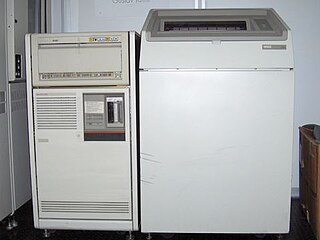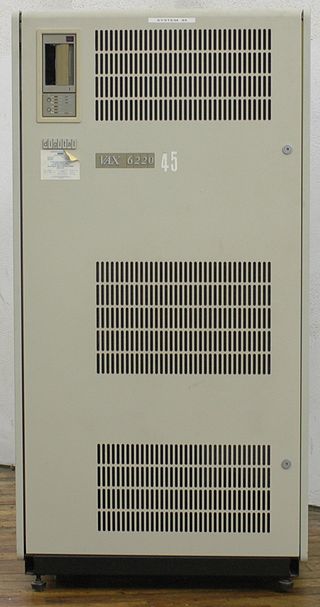Futurebus, or IEEE 896, is a computer bus standard, intended to replace all local bus connections in a computer, including the CPU, memory, plug-in cards and even, to some extent, LAN links between machines. The effort started in 1979 and didn't complete until 1987, and then immediately went into a redesign that lasted until 1994. By this point, implementation of a chip-set based on the standard lacked industry leadership. It has seen little real-world use, although custom implementations continue to be designed and used throughout industry.

The DECstation was a brand of computers used by DEC, and refers to three distinct lines of computer systems—the first released in 1978 as a word processing system, and the latter two both released in 1989. These comprised a range of computer workstations based on the MIPS architecture and a range of PC compatibles. The MIPS-based workstations ran ULTRIX, a DEC-proprietary version of UNIX, and early releases of OSF/1.

The O2 is an entry-level Unix workstation introduced in 1996 by Silicon Graphics, Inc. (SGI) to replace their earlier Indy series. Like the Indy, the O2 uses a single MIPS microprocessor and was intended to be used mainly for multimedia. Its larger counterpart is the SGI Octane. The O2 was SGI's last attempt at a low-end workstation.
The SGI Origin 350 is a mid-range server computer developed and manufactured by SGI introduced in 2003. Their discontinuation in December 2006 brought to a close almost two decades of MIPS and IRIX computing.
The Multia, later re-branded the Universal Desktop Box, was a line of desktop computers introduced by Digital Equipment Corporation on 7 November 1994. The line is notable in that units were offered with either an Alpha AXP or Intel Pentium processor as the CPU, and most hardware other than the backplane and CPU were interchangeable. Both the Alpha and Intel versions were intended to run Windows NT.

The VAXstation is a discontinued family of workstation computers developed and manufactured by Digital Equipment Corporation using processors implementing the VAX instruction set architecture. VAXstation systems were typically shipped with either the OpenVMS or ULTRIX operating systems. Many members of the VAXstation family had corresponding MicroVAX variants, which primarily differ by the lack of graphics hardware.
DECsystem was a line of server computers from Digital Equipment Corporation. They were based on MIPS architecture processors and ran DEC's version of the UNIX operating system, called ULTRIX. They ranged in size from workstation-style desktop enclosures to large pedestal cabinets.

The NVAX is a CMOS microprocessor developed and produced by Digital Equipment Corporation (DEC) that implemented the VAX instruction set architecture (ISA). A variant of the NVAX, the NVAX+, differed in the bus interface and external cache supported, but was otherwise identical in regards to microarchitecture. The NVAX+ was designed to have the same bus as the DECchip 21064, allowing drop-in replacement.

The MicroVAX is a discontinued family of low-cost minicomputers developed and manufactured by Digital Equipment Corporation (DEC). The first model, the MicroVAX I, was introduced in 1983. They used processors that implemented the VAX instruction set architecture (ISA) and were succeeded by the VAX 4000. Many members of the MicroVAX family had corresponding VAXstation variants, which primarily differ by the addition of graphics hardware. The MicroVAX family supports Digital's VMS and ULTRIX operating systems. Prior to VMS V5.0, MicroVAX hardware required a dedicated version of VMS named MicroVMS.

DEC 3000 AXP was the name given to a series of computer workstations and servers, produced from 1992 to around 1995 by Digital Equipment Corporation. The DEC 3000 AXP series formed part of the first generation of computer systems based on the 64-bit Alpha AXP architecture. Supported operating systems for the DEC 3000 AXP series were DEC OSF/1 AXP and OpenVMS AXP.
The DECpc AXP 150, code-named Jensen, is an entry-level workstation developed and manufactured by Digital Equipment Corporation. Introduced on 25 May 1993, the DECpc AXP 150 was the first Alpha-based system to support the Windows NT operating system and the basis for the DEC 2000 AXP entry-level servers. It was discontinued on 28 February 1994, succeeded by the entry-level Multia and the entry-level and mid-range models of the AlphaStation family. The charter for the development and production of the DEC 2000 AXP was held by Digital's Entry Level Solutions Business, based in Ayr, Scotland.
The DEC 7000 AXP and DEC 10000 AXP are a series of high-end multiprocessor server computers developed and manufactured by Digital Equipment Corporation, introduced on 10 November 1992. These systems formed part of the first generation of systems based on the 64-bit Alpha AXP architecture and at the time of introduction, ran Digital's OpenVMS AXP operating system, with DEC OSF/1 AXP available in March 1993. They were designed in parallel with the VAX 7000 and VAX 10000 minicomputers, and are identical except for the processor module(s) and supported bus interfaces. A field upgrade from a VAX 7000/10000 to a DEC 7000/10000 AXP was possible by means of swapping the processor boards.

The SGI Origin 2000 is a family of mid-range and high-end server computers developed and manufactured by Silicon Graphics (SGI). They were introduced in 1996 to succeed the SGI Challenge and POWER Challenge. At the time of introduction, these ran the IRIX operating system, originally version 6.4 and later, 6.5. A variant of the Origin 2000 with graphics capability is known as the Onyx2. An entry-level variant based on the same architecture but with a different hardware implementation is known as the Origin 200. The Origin 2000 was succeeded by the Origin 3000 in July 2000, and was discontinued on June 30, 2002.
The VAX 4000 is a discontinued family of low-end minicomputers developed and manufactured by Digital Equipment Corporation using microprocessors implementing the VAX instruction set architecture (ISA). The VAX 4000 succeeded the MicroVAX family, and shipped with the OpenVMS operating system. It was the last family of low-end VAX systems, as the platform was discontinued by Compaq.

The VAX 6000 is a discontinued family of minicomputers developed and manufactured by Digital Equipment Corporation (DEC) using processors implementing the VAX instruction set architecture (ISA). Originally, the VAX 6000 was intended to be a mid-range VAX product line complementing the VAX 8000, but with the introduction of the VAX 6000 Model 400 series, the older VAX 8000 was discontinued in favor of the VAX 6000, which offered slightly higher performance for half the cost. The VAX 6000 family supports Digital's VMS and ULTRIX operating systems.
The VAX 7000 and VAX 10000 are a discontinued family of high-end multiprocessor minicomputers developed and manufactured by Digital Equipment Corporation (DEC), introduced in July 1992. These systems use NVAX microprocessors implementing the VAX instruction set architecture, and run the OpenVMS operating system.

The VAX 8000 is a discontinued family of superminicomputers developed and manufactured by Digital Equipment Corporation (DEC) using processors implementing the VAX instruction set architecture (ISA).

The Alpha 21064 is a microprocessor developed and fabricated by Digital Equipment Corporation that implemented the Alpha instruction set architecture (ISA). It was introduced as the DECchip 21064 before it was renamed in 1994. The 21064 is also known by its code name, EV4. It was announced in February 1992 with volume availability in September 1992. The 21064 was the first commercial implementation of the Alpha ISA, and the first microprocessor from Digital to be available commercially. It was succeeded by a derivative, the Alpha 21064A in October 1993. This last version was replaced by the Alpha 21164 in 1995.
The Digital Storage Systems Interconnect (DSSI) is a computer bus developed by Digital Equipment Corporation for connecting storage devices and clustering VAX systems. It was designed as a smaller and lower-cost replacement for the earlier DEC Computer Interconnect that would be more suitable for use in office environments. DSSI was superseded by Parallel SCSI.
The Ultra 60 is a fairly large and heavy computer workstation in a tower enclosure from Sun Microsystems. The Ultra 60 was launched in November 1997 and shipped with Solaris 7. It was available in several specifications.








